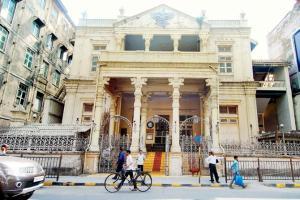The petitioner asked the HC to reject the report on Metro III, stating that the institute had merely relied on data provided by MMRCL and not done any independent investigation

The community seeks to protect the Wadia and Anjuman Atash Behram on Jagannath Sunkersett Road. File pic
In the ongoing battle to save their fire temples from Metro III, the Parsi community has raised objections against the recommendations of the expert committee from Veermata Jijabai Technological Institute (VJTI). In an affidavit filed before the Bombay High Court on Monday, petitioner Jamshed Noshir Sukhadwala, a structural engineer by profession, alleged that the report lacks independent analysis and solely relies on data provided by Mumbai Metro Rail Corporation Limited (MMRCL).
ADVERTISEMENT
Referring to the observations as 'glaring and disturbing', Sukhadwala argued that VJTI had relied on documents prepared by MMRC contractors, and had not done any independent investigation, analysis or scrutiny before drafting the report. The petitioner further rued that the committee hadn't even referred to any of the arguments put forth by the members of the Parsi community. "We had given our written submissions and made an oral presentation for the VJTI committee on August 2. Unfortunately, they did not take any cognisance of the points we raised," he said.
Background
The Parsi vs Metro battle moved to the courtroom on May 23, when the community had moved the HC to seek assurance that the Metro III tunnel should not go anywhere under the Wadia Atash Behram and Anjuman Atash Behram, which are 188 and 120 years old respectively. On July 25, the HC commissioned a report from an independent body and had directed the three-member expert committee from VJTI to analyse the impact of the proposed Metro work for the construction of the Kalbadevi station. The committee submitted its report on August 9.
Sukhadwala pointed out that the community does not have the means to consecrate the temples if they are defiled by the Metro work. "We no longer have the same quality or number of priests to perform the ceremonies to consecrate the premises. So we have to ensure that the Atash Behrams are preserved," he said. He added, "The water level in the wells is currently between 2-3 metres. Based on MMRC's analysis, draw down of ground water level would be around 1 metre at wells located near the cut and cover premises. All our ceremonies have to be performed using fresh water taken from the well. If the water level drops then all our ceremonies will come to a halt," he said.
Despite several calls and messages, neither K K Sangle, coordinator of the expert committee, nor MMRC officials were available for comment. The petitioner's advocate, Bergis Desai, said that the High Court bench of Justices Abhay Oka and Riyaz Chagla directed MMRC to respond to the affidavit, as well as the recommendations made by VJTI, and whether or not they can be implemented, by the next hearing on August 20.
188
Age of Wadia Atash Behram
120
Age of Anjuman Atash Behram
VJTI report
The VJTI report stated that the proposed tunneling work for Metro III will not adversely affect the temples or the level and quality of water in the wells within the premises. The report added that drilling line holes and controlled blasting would reduce the vibration on the structures. However, Sukhadwala raised concerns about collateral damage to nearby buildings or even serious accidents involving loss of lives.
Catch up on all the latest Crime, National, International and Hatke news here. Also download the new mid-day Android and iOS apps to get latest updates
 Subscribe today by clicking the link and stay updated with the latest news!" Click here!
Subscribe today by clicking the link and stay updated with the latest news!" Click here!






